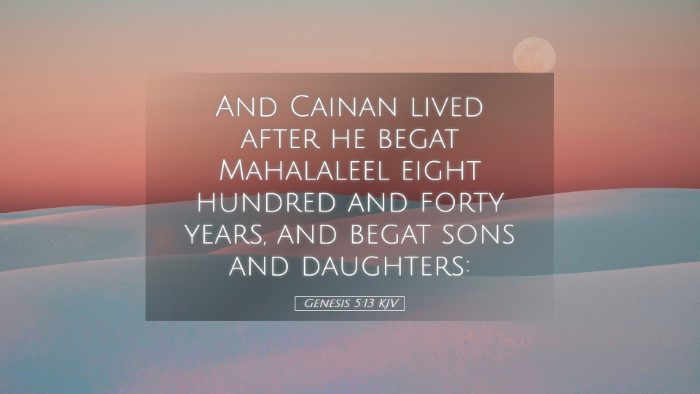Gen 5:13 - Commentary on Genesis 5:13
Genesis 5:13 states:
"And the sum of the years of Enosh was nine hundred and five years; and he died."
Historical Context
This verse falls within a genealogy that tracks the lineage from Adam to Noah. The focus is on Enosh, Adam's grandson, the son of Seth. This genealogy serves a dual purpose: it upholds the continuity of God's creation and highlights the gradual decline of human lifespan and holiness.
Commentary Insights
Matthew Henry's Commentary
Historical Significance: Henry emphasizes the significance of Enosh's name, which means "mortal" or "man," reflecting the fragility of human life in contrast to God's eternality. The lifespan of Enosh, nine hundred and five years, while impressive, still ends in death, reinforcing human mortality.
Spiritual Implication: According to Henry, the death noted in this genealogy serves as a reminder of the consequences of sin. The initial promise of eternal life was forfeited due to Adam's transgression, and each generation serves as a witness to the ongoing decay of humanity.
Albert Barnes' Notes
Numerical Significance: Barnes draws attention to the exact length of Enosh's life as part of a larger pattern in the genealogies of Genesis. He notes the importance of recording ages, signifying the transitional nature of human existence. The figure 905 symbolizes a fullness of life that ultimately leads to death.
Pattern of Genealogy: Furthermore, Barnes discusses the structured nature of these genealogical records, pointing out how each entry substantiates the unfolding narrative of God's overarching plan through successive generations.
Adam Clarke's Commentary
Enosh's Place in History: Clarke elaborates on Enosh, acknowledging his role in establishing the first formal worship of God. This suggests that during his lifetime, there was a pivotal shift from mere survival to spiritual awareness and cultural development.
Theological Reflections: Clarke also reflects on the theological implications of longevity. He suggests that the extended lifespans during this antediluvian period were a grace from God, allowing humanity the opportunity to seek Him despite sin's darkening influence.
Overall Theme and Application
The overarching theme of Genesis 5:13 revolves around the tension between human mortality and divine providence. Despite the long lives recorded, each individual mentioned ultimately succumbs to death, which highlights the reality of human sinfulness and the necessity for redemption.
Lessons for Today
- The Urgency of Seeking God: Like Enosh, who led his people to seek the Lord, modern believers are encouraged to pursue a relationship with God amidst life's fleeting nature.
- Values of Spiritual Legacy: The genealogies remind believers of the importance of leaving a spiritual legacy, one that prioritizes faithfulness to God’s ways across generations.
- Hope Beyond Death: While the verse concludes with death, it serves as a precursor to the hope offered in the gospel—life eternal through Christ, contrasting the death noted in the genealogies of Genesis.


